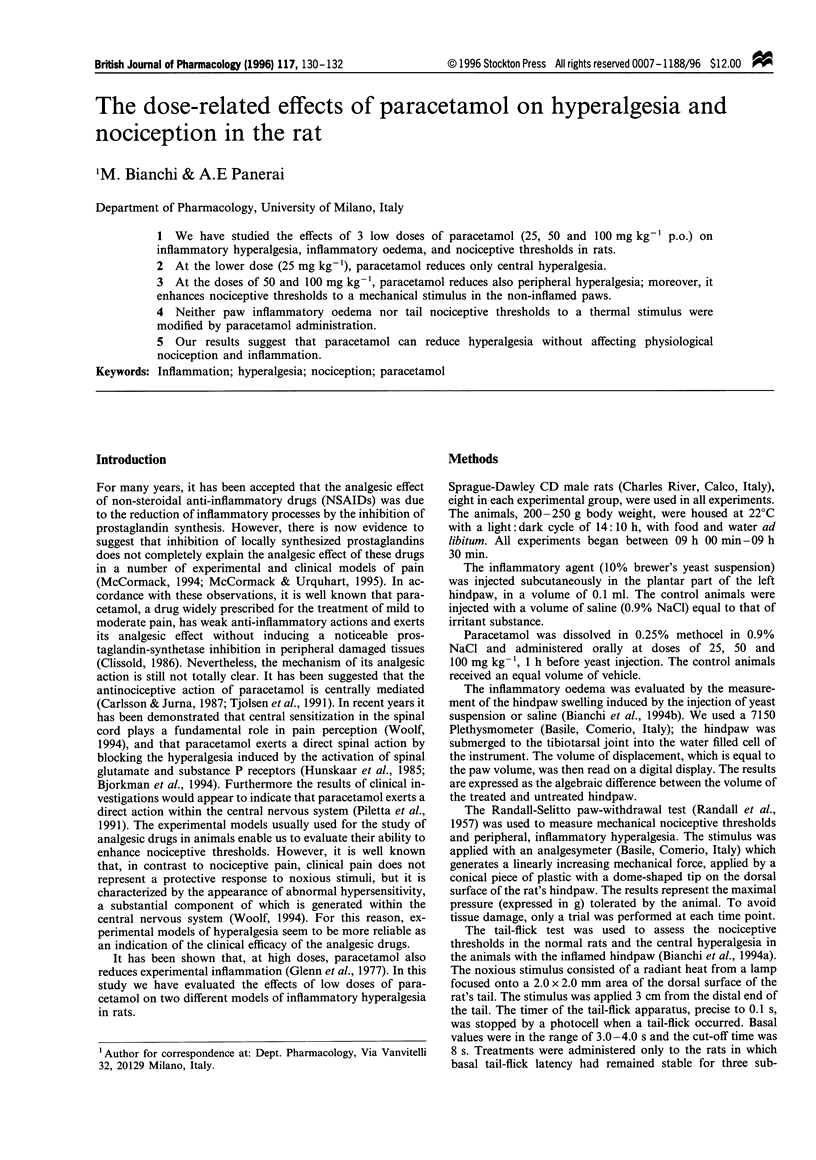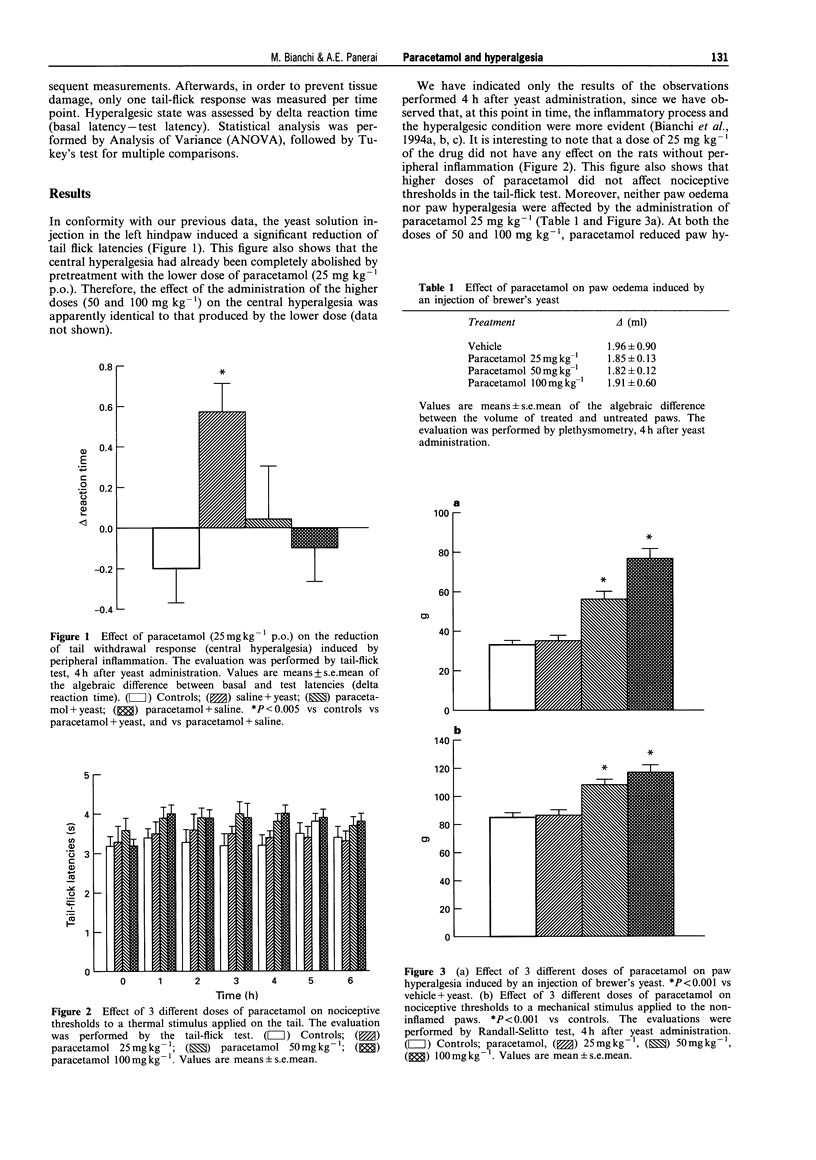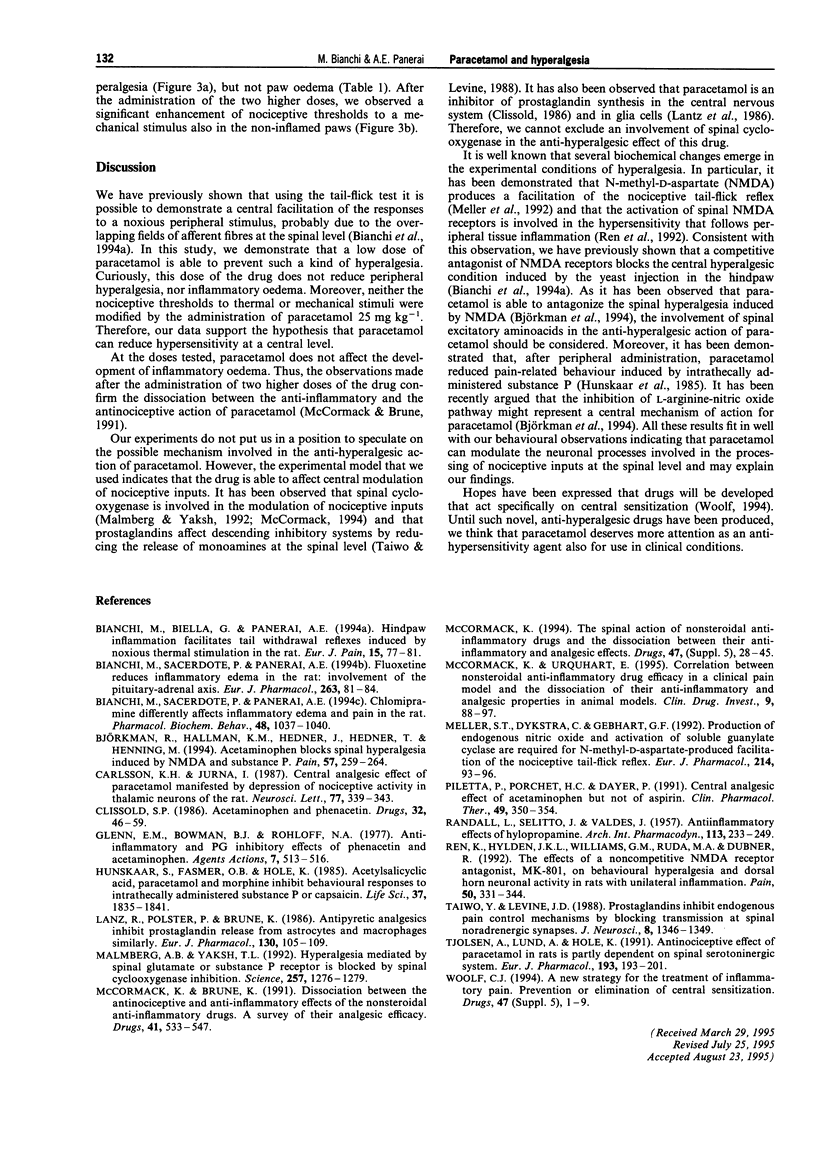Abstract
1. We have studied the effects of 3 low doses of paracetamol (25, 50 and 100 mg kg-1 p.o.) on inflammatory hyperalgesia, inflammatory oedema, and nociceptive thresholds in rats. 2. At the lower dose (25 mg kg-1), paracetamol reduces only central hyperalgesia. 3. At the doses of 50 and 100 mg kg-1, paracetamol reduces also peripheral hyperalgesia; moreover, it enhances nociceptive thresholds to a mechanical stimulus in the non-inflamed paws. 4. Neither paw inflammatory oedema nor tail nociceptive thresholds to a thermal stimulus were modified by paracetamol administration. 5. Our results suggest that paracetamol can reduce hyperalgesia without affecting physiological nociception and inflammation.
Full text
PDF


Selected References
These references are in PubMed. This may not be the complete list of references from this article.
- Bianchi M., Sacerdote P., Panerai A. E. Chlomipramine differently affects inflammatory edema and pain in the rat. Pharmacol Biochem Behav. 1994 Aug;48(4):1037–1040. doi: 10.1016/0091-3057(94)90217-8. [DOI] [PubMed] [Google Scholar]
- Bianchi M., Sacerdote P., Panerai A. E. Fluoxetine reduces inflammatory edema in the rat: involvement of the pituitary-adrenal axis. Eur J Pharmacol. 1994 Sep 22;263(1-2):81–84. doi: 10.1016/0014-2999(94)90526-6. [DOI] [PubMed] [Google Scholar]
- Björkman R., Hallman K. M., Hedner J., Hedner T., Henning M. Acetaminophen blocks spinal hyperalgesia induced by NMDA and substance P. Pain. 1994 Jun;57(3):259–264. doi: 10.1016/0304-3959(94)90001-9. [DOI] [PubMed] [Google Scholar]
- Carlsson K. H., Jurna I. Central analgesic effect of paracetamol manifested by depression of nociceptive activity in thalamic neurones of the rat. Neurosci Lett. 1987 Jun 26;77(3):339–343. doi: 10.1016/0304-3940(87)90524-6. [DOI] [PubMed] [Google Scholar]
- Clissold S. P. Paracetamol and phenacetin. Drugs. 1986;32 (Suppl 4):46–59. doi: 10.2165/00003495-198600324-00005. [DOI] [PubMed] [Google Scholar]
- Glenn E. M., Bowman B. J., Rohloff N. A. Anti-inflammatory and PG inhibitory effects of phenacetin and acetaminophen. Agents Actions. 1977 Dec;7(5-6):513–516. doi: 10.1007/BF02111123. [DOI] [PubMed] [Google Scholar]
- Hunskaar S., Fasmer O. B., Hole K. Acetylsalicylic acid, paracetamol and morphine inhibit behavioral responses to intrathecally administered substance P or capsaicin. Life Sci. 1985 Nov 11;37(19):1835–1841. doi: 10.1016/0024-3205(85)90227-9. [DOI] [PubMed] [Google Scholar]
- Lanz R., Polster P., Brune K. Antipyretic analgesics inhibit prostaglandin release from astrocytes and macrophages similarly. Eur J Pharmacol. 1986 Oct 14;130(1-2):105–109. doi: 10.1016/0014-2999(86)90188-3. [DOI] [PubMed] [Google Scholar]
- Malmberg A. B., Yaksh T. L. Hyperalgesia mediated by spinal glutamate or substance P receptor blocked by spinal cyclooxygenase inhibition. Science. 1992 Aug 28;257(5074):1276–1279. doi: 10.1126/science.1381521. [DOI] [PubMed] [Google Scholar]
- McCormack K., Brune K. Dissociation between the antinociceptive and anti-inflammatory effects of the nonsteroidal anti-inflammatory drugs. A survey of their analgesic efficacy. Drugs. 1991 Apr;41(4):533–547. doi: 10.2165/00003495-199141040-00003. [DOI] [PubMed] [Google Scholar]
- McCormack K. The spinal actions of nonsteroidal anti-inflammatory drugs and the dissociation between their anti-inflammatory and analgesic effects. Drugs. 1994;47 (Suppl 5):28–47. doi: 10.2165/00003495-199400475-00006. [DOI] [PubMed] [Google Scholar]
- Meller S. T., Dykstra C., Gebhart G. F. Production of endogenous nitric oxide and activation of soluble guanylate cyclase are required for N-methyl-D-aspartate-produced facilitation of the nociceptive tail-flick reflex. Eur J Pharmacol. 1992 Apr 7;214(1):93–96. doi: 10.1016/0014-2999(92)90102-a. [DOI] [PubMed] [Google Scholar]
- Piletta P., Porchet H. C., Dayer P. Central analgesic effect of acetaminophen but not of aspirin. Clin Pharmacol Ther. 1991 Apr;49(4):350–354. doi: 10.1038/clpt.1991.40. [DOI] [PubMed] [Google Scholar]
- RANDALL L. O., SELITTO J. J., VALDES J. Anti-inflammatory effects of xylopropamine. Arch Int Pharmacodyn Ther. 1957 Dec 1;113(1-2):233–249. [PubMed] [Google Scholar]
- Ren K., Hylden J. L., Williams G. M., Ruda M. A., Dubner R. The effects of a non-competitive NMDA receptor antagonist, MK-801, on behavioral hyperalgesia and dorsal horn neuronal activity in rats with unilateral inflammation. Pain. 1992 Sep;50(3):331–344. doi: 10.1016/0304-3959(92)90039-E. [DOI] [PubMed] [Google Scholar]
- Taiwo Y. O., Levine J. D. Prostaglandins inhibit endogenous pain control mechanisms by blocking transmission at spinal noradrenergic synapses. J Neurosci. 1988 Apr;8(4):1346–1349. doi: 10.1523/JNEUROSCI.08-04-01346.1988. [DOI] [PMC free article] [PubMed] [Google Scholar]
- Tjølsen A., Lund A., Hole K. Antinociceptive effect of paracetamol in rats is partly dependent on spinal serotonergic systems. Eur J Pharmacol. 1991 Feb 7;193(2):193–201. doi: 10.1016/0014-2999(91)90036-p. [DOI] [PubMed] [Google Scholar]
- Woolf C. J. A new strategy for the treatment of inflammatory pain. Prevention or elimination of central sensitization. Drugs. 1994;47 (Suppl 5):1–47. doi: 10.2165/00003495-199400475-00003. [DOI] [PubMed] [Google Scholar]


